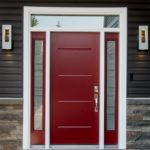Kohltech has windows and doors that have achieved the rigorous certification standard of the Passive House Institute US. Below is an outline of the Passive House standard followed by the Kohltech products and options available to meet the standard. A Passive House is essentially a super-insulated house that exceeds most existing standards relating to energy usage. There are only 13 Manufacturers in North America and only 2 in Canada that have window products certified for this program. Kohltech is currently only one of 2 manufacturers in Canada to have certified door products.
Kohltech Passive House windows and doors will ship with a Passive House Institute US Certification label as shown in the sections below.
Kohltech Certified Windows & Options
Below is a list of Kohltech’s Passive House Certified window lines and the options available. Please visit your nearest dealer for more information.
Window Types
Window Series
| Supreme |
Mullion
Non-Reinforced Mullions with a span of 60″ or below and the interval between spans is to be no more than 38″.
Glass Options
Options
| Installation | Brick ties are required |
| Brickmoulds and Nailing Fin | No restrictions on brickmould or nailing fin |
| Jamb Extension | No restrictions on jamb extension |
| Grilles | Available on Casement & Double Hung |
Passive House (PHIUS) Certification Labels
Kohltech Certified Doors & Options
Below is a list of Kohltech’s Passive House Certified cellular PVC doors and the options available. Please visit your nearest dealer for more information.
Products Available
| Inswing & Outswing Single Door | Inswing & Outswing Transom |
| Direct Glazed Sidelite | Inswing & Outswing Fixed Sidelite |
Slab & Frame Types
Steel Slabs & Cellular PVC Frame Only
Mullion
No mulling available at this time. Transoms and Sidelites need to be framed separately.
Glass Options
Doors available with glass only. Lite kits up to size 2264.
Options
| Tint | No tint or laminate options |
| Tempered | Sizes 2248 & 2264 are tempered kits |
| Sill | No assisted living sill. Inswing only. |
| Grilles | No grilles |
| Prep | No panic or closer prep |
Passive House (PHIUS) Certification Labels – Doors, Sidelites & Transoms
Passive House (Passivhaus) Certified Building Standards 
The term passive house refers to a rigorous standard for energy efficiency in buildings. The standard first originated in Germany in 1988 and has now spread across many countries worldwide. Estimates in 2008 of the number of Passive House certified buildings ranged from 15000 to 20000.
There are three rigorous standards that a building must follow to be eligible for Passive House Certification, along with several recommendations. The standards are as follows:
- The building must be designed to have an annual heating and cooling demand as calculated with the Passivhaus Planning Package of not more than 15 kWh/m2 (4,2755 BTU/ft.; 5.017 MJ/sq. ft.) per year in heating or cooling energy OR be designed with a peak heat load of 10 W/m2 (1.2 hp/1000 sq. ft.)
- Total primary energy(source energy for electricity, etc.) consumption (primary energy for heating, hot water and electricity) must not be more than 120 kWh/m2 (38,040 BTU/sq ft; 40.13 MJ/sq ft) per year
- The building must not leak more air than 0.6 times the house volume per hour (n50≤ 0.6 / hour) at 50 Pa (0.0073 psi) as tested by a blower door, OR alternatively when looked at the surface area of the enclosure, the leakage rate must be less than 0.05 cubic feet per minute
- The specific heat load for the heating source at design temperature is recommended, but not required, to be less than 10 W/m2 (3.17 BTU/h.ft2)







